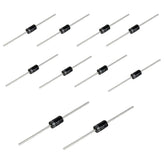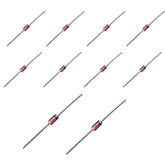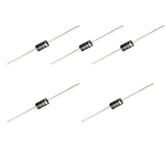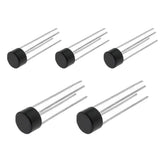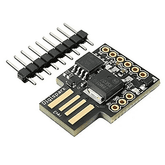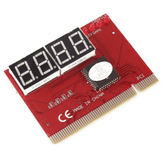Introduction to Diodes
Summary
Discover the fundamental world of diodes in our latest blog, "Introduction to Diodes." Uncover the basics with insights into what diodes are and the various types available. Delve into their diverse applications, exploring how diodes are constructed and manufactured. Peek into the future of diode technology, offering a glimpse of innovations to come. Engage with the evolution of electronic components that power our world. Join us on a journey through the heart of diodes, unlocking their potential and shaping the future of technology. Don't miss out – read on for an electrifying adventure!
Introduction
Diodes stand as one of the most fundamental and ubiquitous electronic components, yet their operations occur discreetly, rarely basking in the limelight. These seemingly simple semiconductor devices exhibit a deceptively straightforward functionality - allowing electric current to flow in one direction while blocking it in the reverse direction. However, this modest asymmetric conduction enables diodes to impart profound influence through a diverse array of electronics applications.
Rectification constitutes the diode's cardinal function, conferring capabilities like converting alternating currents (AC) into direct currents (DC), constructing voltage regulators, demodulating communications signals, and shaping waveforms. Hardly any electronic system exists without benefitting from diodes somewhere within its circuits.
This article unravels the basics of diode operation, surveys some popular diode varieties, and spotlights some of their ubiquitous applications. A crisp overview of diodes illuminates how these simple semiconductor devices pervade electronics and quietly better our lives.

In essence, a diode constitutes a two-terminal electronic component, containing an anode and a cathode, built upon a semiconductor p-n junction. The asymmetry of the p-n junction fabricates the diode's defining nonlinear current-voltage characteristics. Forward-biasing the diode prompts current conduction, while reverse-biasing inhibits current flow. This core rectifying behavior lays the groundwork for diodes' far-reaching utility.
What Are Diodes?
The diode derives its name from its two-terminal configuration and unilateral current flow properties. While resistors accommodate current equally well in both directions between terminals, diodes restrict flow to just one direction. This facet imbues diodes with the ability to rectify alternating currents into direct currents.
Structurally, a standard diode comprises a single p-n junction, formed by adjoining a positively doped p-type semiconductor material to a negatively doped n-type material. Doping injects impurity atoms to donate free charge carriers - holes in p-type regions and electrons in n-type regions. The juxtaposition produces an electric field at the metallurgical junction interface due to the charge carrier diffusion that transpires there. An equilibrium eventually is attained wherein a depletion region manifests devoid of free carriers.
The differing chemical compositions of the p-type and n-type materials beget distinct electrical properties on either side of the junction. The imbalance of hole and electron densities concentrates electrons on the n-side and holes on the p-side. This charge separation generates an innate built-in potential across the junction.
When the diode obtains forward biasing through the anode positive voltage, the built-in potential of the electric field is diminished, narrowing the depletion region width. Current is thus conducted readily across the junction as electrons and holes recombine. However, under reverse bias, the electric field is intensified, widening the depletion region and inhibiting carrier injection and recombination. This thwarts current flow. I
n essence, diodes exhibit an asymmetry in their current-voltage profile. The diode allows appreciable current passage exclusively in the forward direction. The p-n junction structure imposes a low resistance to forward current but a high resistance to reverse current. Thereby, the diode acts as a unilateral electronic valve or rectifier.

The current-voltage relationship governing an ideal diode follows the Shockley diode equation or the approximate model:
I = I0(eqV/kT - 1)
where I is the diode current, I0 is the reverse saturation current, q is the electron charge, V is the voltage across the diode, k is Boltzmann's constant, and T is absolute temperature.
This equation indicates an exponential increase in forward current with increasing positive voltage, while negligible reverse current flows with negative voltage. Real diodes exhibit some leakage but otherwise follow this ideal diode profile.
The diode's asymmetric semiconducting p-n junction physics furnishes its defining nonlinear current-voltage characteristics and rectification capabilities. Diodes thereby function as essential polarity-sensitive electronic valves.
Types of Diodes
Diodes come in a veritable potpourri of flavors tailored toward specialized applications. Myriad diode varieties exist, but we will survey some of the more common types here.
Rectifier Diodes
These ubiquitous diodes function primarily in rectifying alternating currents into direct currents via their asymmetric conduction properties. Silicon diodes serve as typical rectifier diodes due to silicon's ideal semiconductor bandgap. Rectifiers are employed extensively in power supplies for electronic devices.
Schottky Diodes
Schottky diodes incorporate a metal-semiconductor junction rather than a p-n junction, enabling faster switching speeds and lower forward voltage drops. Their capabilities lend well to switching, clamping, and RF detection applications.
Zener Diodes
Zener diodes are designed to allow reverse breakdown to happen at a targeted voltage. Under reverse bias beyond this Zener voltage, significant current flow occurs. This stable voltage drop furnishes voltage regulation capabilities.
Photodiodes
Photodiodes harness the photoelectric effect to absorb incident photons and liberate charge carriers. Photocurrent then flows through the diode proportionally to the light intensity. Photodiodes enable applications like cameras, photodetectors, and fiber optic communications.
Varactor Diodes
These diodes leverage variable capacitance dependent on the applied reverse bias voltage. By altering the width of the junction's depletion region, the diode's capacitance is tuned. Varactor diodes enable voltage-controlled oscillators and frequency modulation applications.
Tunnel Diodes
In these exotic diodes, quantum tunneling of electrons permits negative differential resistance—decreasing current with increasing voltage due to carriers bypassing the depletion region through quantum tunneling. Tunnel diodes function as ultrafast switches and amplifiers.
PIN Diodes
PIN diodes contain an intrinsic semiconductor region between their p and n regions. This augments their RF switching speed by lessening capacitance when reverse biased. PIN diodes serve RF switches and photodetectors.
LEDs
Forward-biased light emitting diodes recombine electrons and holes to produce photons through electroluminescence. LEDs provide illumination for displays, indicators, and general lighting applications.
Laser Diodes
Similar to LEDs but configured with cleaved reflective end facets to generate coherent stimulated emission. Laser diodes enable fiber optic communications, barcode scanning, laser printing, and other applications.
Avalanche Diodes
These diodes purposefully operate in avalanche breakdown mode to furnish a constant voltage reference for regulators. The abrupt breakdown effect regulates voltage precisely.

This sampling of diode varieties exhibits the adaptability of the fundamental p-n junction structure to address an array of functions through distinctive semiconductor physics. The simple diode continues to find novel applications across the electronics landscape.
Applications of Diodes
The venerable diode pervades electronics, operating behind the scenes of countless systems and devices. Let's spotlight some of the places diodes inhabit within modern technology.
Power Supplies
Diodes such as rectifiers convert AC into pulsating DC, while capacitor filters smooth the pulsations into steady DC for powering electronics. Bridge rectifiers efficiently convert single-phase AC into DC.
Voltage Regulation
Zener diodes govern excess voltages through their avalanche breakdown properties. This regulates power supply outputs and shields sensitive components from voltage spikes and surges.
Switching
High-speed diodes rapidly switch signals or power, functioning essentially as electronic toggles. Varactor, PIN, tunnel, and Schottky diodes adaptively manipulate their junctions to swiftly transition between conductive and resistive states.
Signal Rectification
Diodes rectify alternating signals into direct pulsating signals by clipping either the positive or negative halves of the signal. Envelope detector diodes extract the amplitude envelope from modulated waveforms.
Clamping Circuits
Diodes clamp voltages to keep signals within certain prescribed levels, preventing overvoltage damage. They function similarly to Zener shunt regulators.
Current Steering
Diodes steer current flows based on their polarity sensitivity. Multi-element diode networks distribute currents across various branches depending on diode orientations.
Logic Gates
Combinations of diodes realize vital Boolean logic operations like AND, OR, and NOT that constitute the basis of digital electronics. Diode logic was essential in early computers.
RF Switching
PIN and varactor diodes work well as RF switches and modulators due to their fast switching capability and variable capacitance, enabling adaptive RF electronics.
Photodetection
Photodiodes and phototransistors sense light levels and can convert optical signals into electronic signals, crucial for fiber optic communications.
Charge Storage
The junction capacitance intrinsic to diodes allows them to store electric charges. Varactors leverage this for capacitance tuning.
Light Emission
LEDs and laser diodes convert electricity into photons through electroluminescence and stimulated emission. They enable displays, indicators, fiber optic links, barcode scanners, and other photonic applications.
Mixing
Varactor and step recovery diodes can electronically combine radio frequency signals to translate their frequencies up or down. This facilitates radio tuning and superheterodyne receivers.
Voltage Multiplication
Cascaded diode capacitor voltage multiplier circuits generate multiplication of an input voltage. This allows high voltage generation from lower voltages.
Electrostatic Discharge Protection
Diodes shunt dangerous ESD spike currents away from sensitive electronics to protect against damage. TVS diodes and Zener clamps perform this role.
Clearly, the versatile functionalities of the humble diode pervade electronics from micro to macro scales. Silicon diodes may reign supreme for general purposes, but other specialized diodes also carve important niches across the electronics landscape. Diodes will undoubtedly continue enlightening our lives well into the future.
How Are Diodes Constructed and Manufactured
We have covered how diodes operate and their manifold applications, but have yet to elucidate their physical construction. Diodes contain fragile p-n junctions built upon semiconductor materials through intricate fabrication processes. Let's overview diode architecture and manufacturing.
Most diodes integrate into discrete packaged components containing single semiconductor dies encapsulated in protective housings. But diodes also commonly integrate monolithically into ICs by patterning the p-n junctions directly onto circuits.
Semiconductor Materials
Silicon dominates as the foremost material for diodes due to its ideal bandgap energy and abundant availability. But diodes also utilize other semiconductors like germanium, gallium arsenide, and silicon carbide for niche applications.
Doping Profiles
Diode fabrication entails doping silicon via introduction of n-type (phosphorus or arsenic) and p-type (boron or gallium) dopants. Modern processes precisely control doping densities through thermal diffusion or ion implantation to tailor diode properties.
Die Fabrication
Junction fabrication employs thermal diffusion or ion implantation to introduce dopants into the semiconductor substrate. Thin film deposition grows metallic contacts, and photolithographic patterning transfers the diode structure into the substrate.
Passivation and Terminals
Die surfaces get passivated with oxide or nitride layers to protect the junctions. Aluminum or gold metallization provides wiring contacts for the cathode and anode terminals.
Assembly and Packaging
Bare dies mount into protective packages with terminals, and bond wires electrically connect the die pads to package leads. Common packages include through-hole DIP or axial leaded "glass diode" formats.
Quality Control Testing
Diodes undergo electrical testing at the wafer and packaged stages. Parameters like forward voltage and reverse leakage current are checked for specification compliance via automated test systems.
Diode manufacturing leverages a succession of intricate semiconducting processes to translates diode designs into functional devices ready for circuit integration. The p-n junction forms the essence of the diode, but advanced fabrication perfects this delicate structure for reliability.
The Future of Diode Technology
Diodes have progressed tremendously over the decades, but what does the future hold for diode technology? Several trends appear poised to advance diodes further.
Novel Semiconductors
Wide bandgap semiconductors like silicon carbide and gallium nitride promise diodes with lower losses, higher operating temperatures and voltages, and improved high frequency performance compared to silicon.
Nanoscale Structures
Diode nanostructures like nanowires give potential to shrink diode dimensions for high density integration. Quantum tunneling diodes using nanoscale elements also are emerging.
Flexible and Printed Forms
Diodes built on thin flexible polymer substrates via printed electronics processes enable conformal integration onto irregular surfaces for innovative applications.
Heterojunctions
Diodes with heterojunctions combining multiple semiconductor materials provide opportunities to engineer enhanced properties by leveraging discontinuities in the band structure.
Optoelectronic Integration
Monolithic integration of diodes alongside transistors, sensors and photonics devices enables smart optoelectronic ICs for optical communications, imaging, displays, and sensing.
Harsh Environment Robustness
Diodes made of wide bandgap semiconductors can withstand extreme temperatures, radiation doses, and thermal cycling, beneficial for space, military and downhole applications.
While the conventional silicon diode remains a staple component, continued materials and fabrication advances promise to unlock novel diode capabilities to empower next-generation electronics.
Conclusion
Though the unassuming diode takes a backseat to more sophisticated electronics, its influence perseveres ubiquitously within circuits small and large. By simply conducting current in one direction while blocking it in the other, diodes bestow systems with crucial rectifying, switching, regulating, and detecting functionalities.
Engineering the marvelous electrical properties of semiconductor p-n junctions imparts diodes their unique conduction asymmetry. This catalytic nonlinearity at heart enables diodes' versatility at the component level. An ensemble of diodes integrated creatively within circuitry then provides the foundations for managing electricity in electronics.
So while the glamorous transistor garners accolades for powering the digital age, the humble diode deserves credit for quietly toiling away as a crucial electronics workhorse for over a century and counting. From power supplies, radios and televisions, to computers, smartphones, vehicles, and modern microelectronics, ubiquitous diodes silently pervade electronics everywhere. Diodes will undoubtedly continue bettering our electron-powered society in subtle yet profound ways for decades more.



